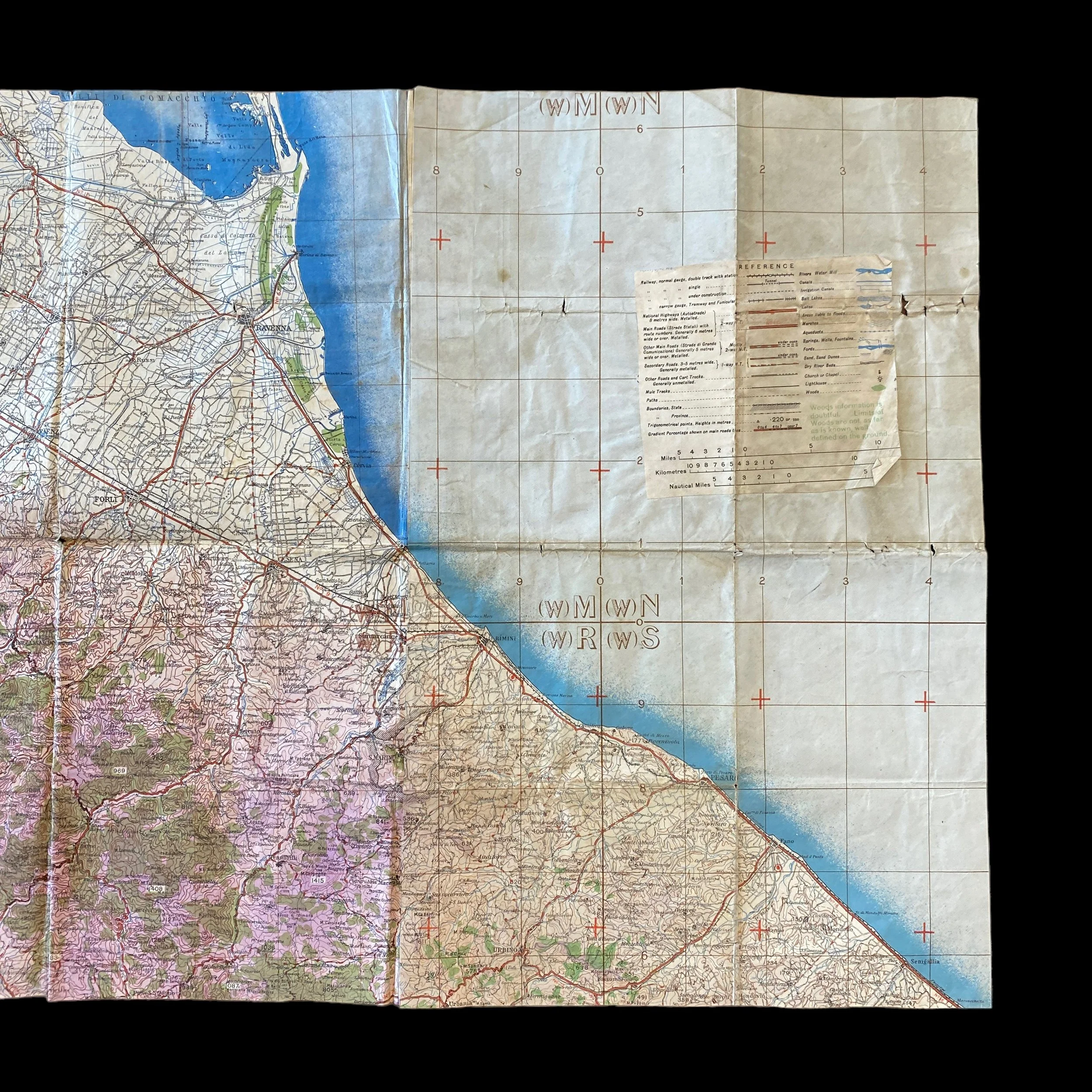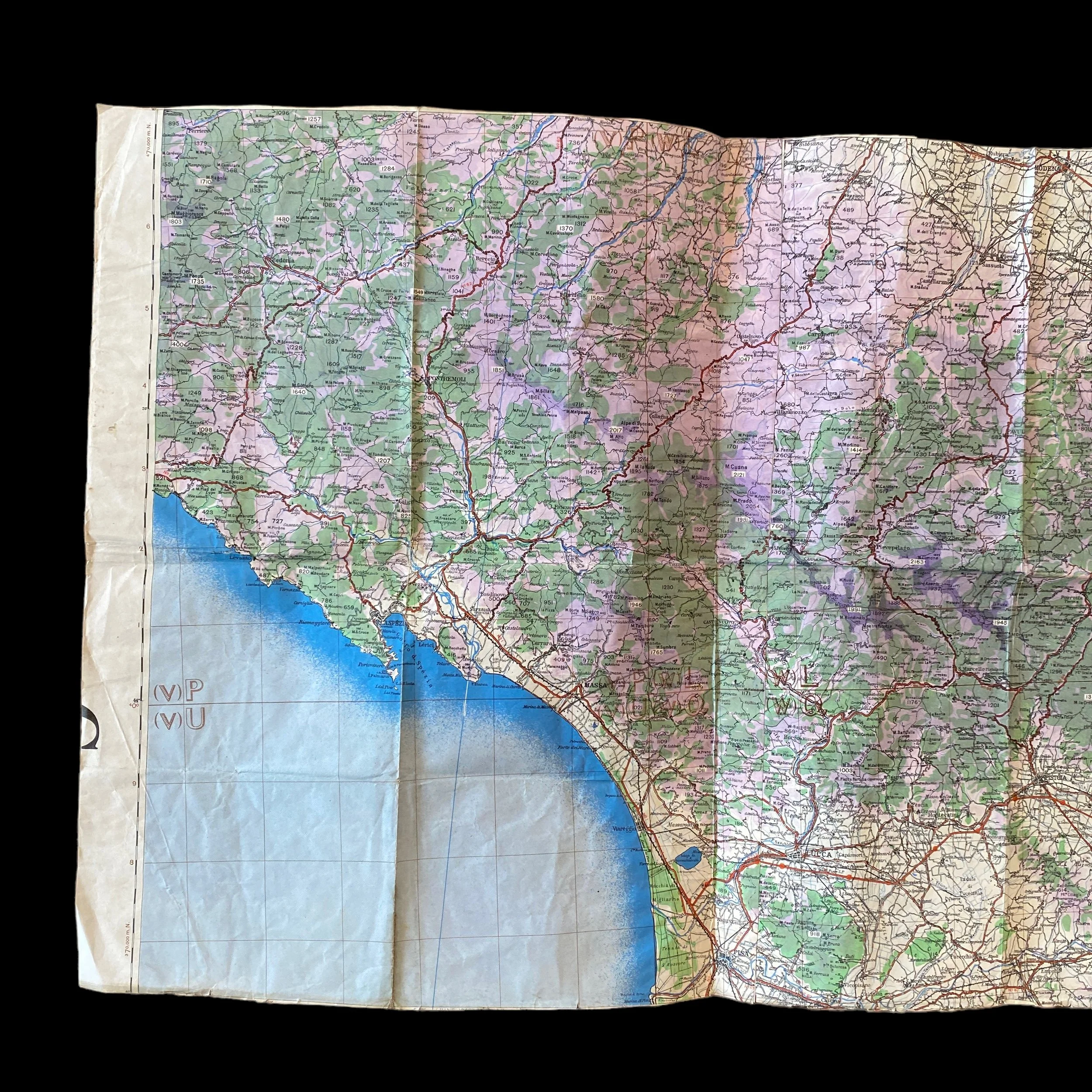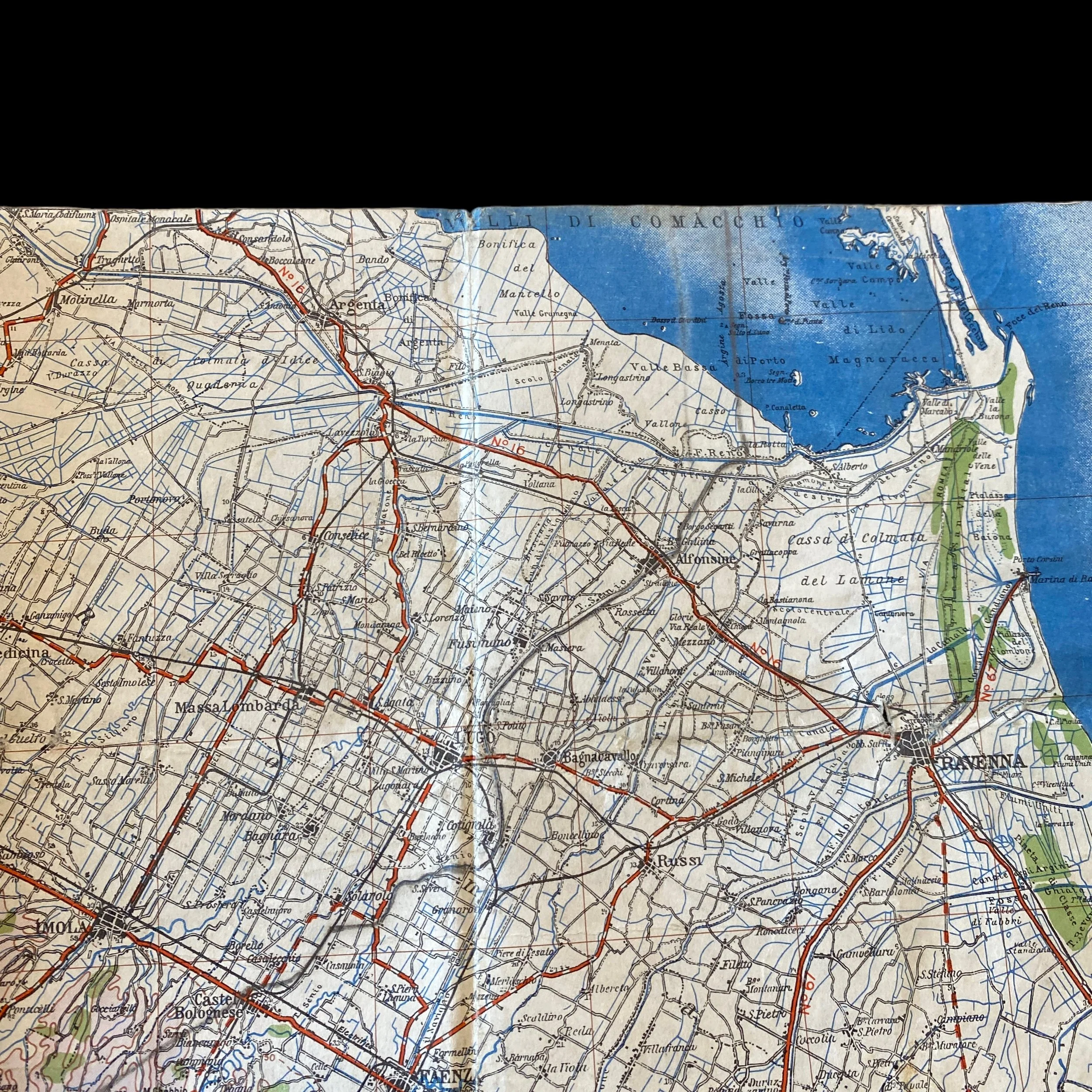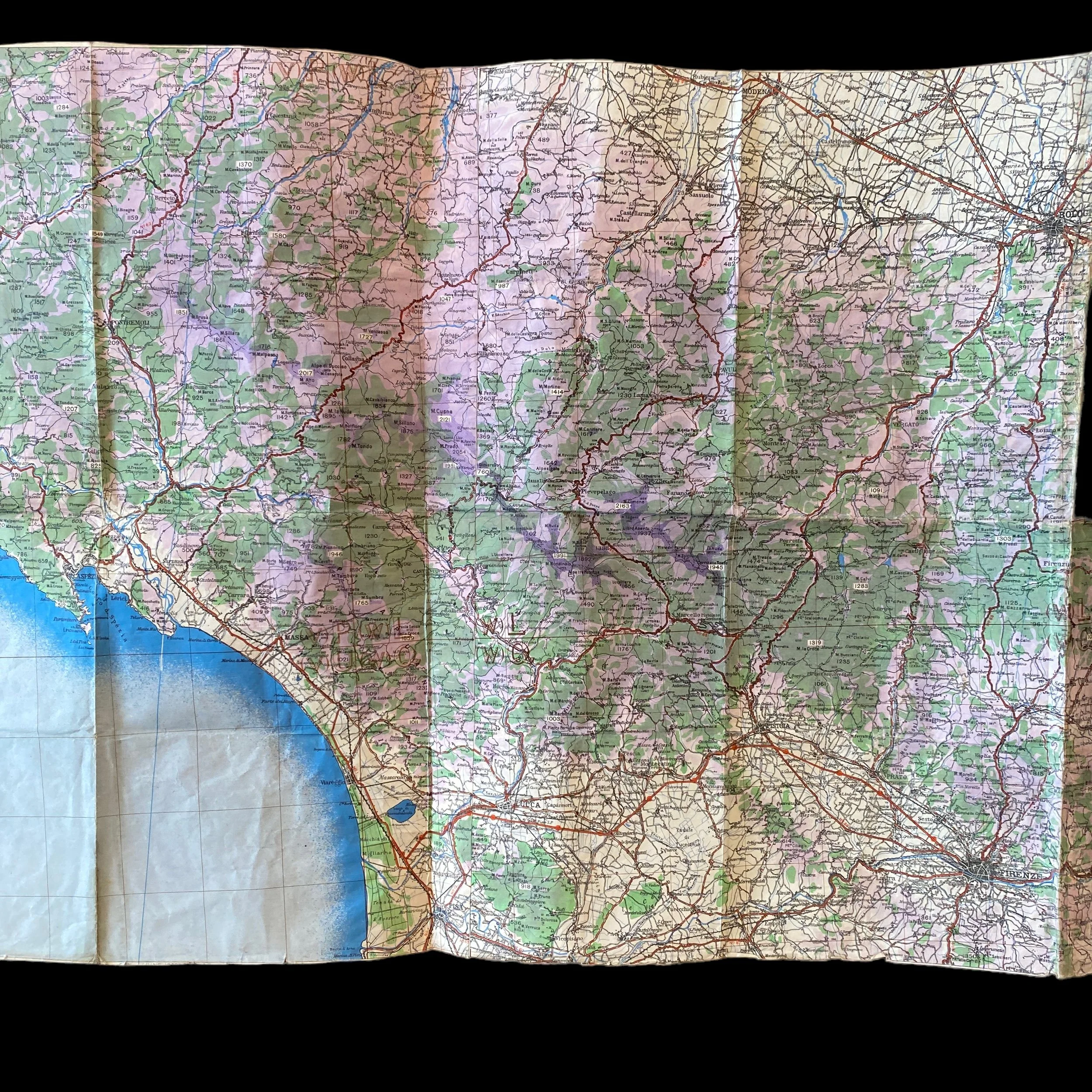VERY RARE! WWII U.S. Italian Campaign Large HQ Map Gothic Line & Futa Pass































VERY RARE! WWII U.S. Italian Campaign Large HQ Map Gothic Line & Futa Pass
Comes with hand-signed C.O.A.
*THIS VERY RARE HQ MAP SHOWS THE HAND-DRAWN FRONT LINE OF THE GOTHIC PASS AS DRAWN ON THE MAP WITH COMBAT MARKINGS.
This very rare and museum-grade U.S. Italian Campaign Large HQ Map stands as a testament to the intricate planning and strategic brilliance that characterized the Allied advance through Italy during World War II. This expansive panoramic-type map, meticulously pieced together from multiple smaller Allied Italy maps, played a pivotal role in guiding the U.S. Infantry and Armored Division Headquarters as they maneuvered through the challenging terrain of the Italian peninsula. This research delves into the historical significance of this large HQ map, exploring its creation, application, and the crucial role it played during the relentless push towards the formidable Gothic Line and Futa Pass.
The assault on the Gothic Line during World War II stands as a pivotal moment in the conflict, representing a significant chapter in the Allied campaign to liberate Italy from German occupation. The Gothic Line, also known as the Green Line, was a formidable defensive position established by the Germans in the northern part of Italy, stretching from the Tyrrhenian Sea to the Adriatic. This defensive line, fortified with bunkers, trenches, and other military installations, posed a formidable obstacle for the advancing Allied forces.
The Gothic Line was constructed by the Germans in 1943 as part of their defensive strategy to halt the Allied advance in Italy. The Germans, under the command of Field Marshal Albert Kesselring, recognized the strategic importance of the Italian peninsula and sought to create a defensive line that would be nearly impregnable. The rugged terrain of the Apennine Mountains provided a natural barrier, and the Germans augmented this advantage by constructing a complex network of fortifications, minefields, and anti-tank obstacles.
The assault on the Gothic Line began in earnest in the summer of 1944. The Allied forces, primarily composed of American, British, and Commonwealth troops, faced the daunting task of breaching this heavily fortified defensive line. The campaign to overcome the Gothic Line was characterized by fierce battles, challenging terrain, and a tenacious German defense.
One of the key elements of the Allied strategy was a series of coordinated attacks along various points of the Gothic Line. The intention was to stretch German defenses thin and exploit potential weaknesses in the enemy's lines. The American forces played a significant role in this assault, contributing both manpower and strategic expertise to the overall campaign.
The assault on the Gothic Line was marked by intense fighting in several key locations. One such notable battle was the Battle of Rimini, which took place in September 1944. Rimini, a crucial city located on the Adriatic coast, was heavily defended by German forces. The Allied advance in this region was met with fierce resistance, as the Germans utilized the natural defenses of the terrain and the fortified positions of the Gothic Line to their advantage.
The terrain itself added to the complexity of the assault. The Apennine Mountains, with their steep slopes and dense vegetation, made maneuvering and coordination challenging for the Allied forces. The Germans, well-acquainted with the terrain, exploited its natural features to create defensive positions that were difficult to breach.
Artillery played a crucial role in the assault on the Gothic Line. Both sides utilized heavy artillery barrages to soften enemy defenses and create openings for infantry advances. The mountainous terrain, however, often limited the effectiveness of traditional artillery, requiring innovative tactics and specialized equipment to overcome these challenges.
The success of the assault on the Gothic Line can be attributed to a combination of factors. Allied forces displayed remarkable resilience and adaptability, adjusting their tactics to the unique challenges posed by the Gothic Line's defenses. Additionally, improved coordination between infantry, armor, and artillery units played a crucial role in breaking through the German defenses.
The assault on the Gothic Line had broader implications for the overall Italian campaign and the war effort in Europe. Breaking through this formidable defensive line opened up northern Italy for the Allies, allowing them to advance toward the Po Valley and ultimately liberate the country from German occupation. The successful breach of the Gothic Line marked a turning point in the Italian campaign and contributed to the overall momentum of the Allied advance in Europe.
Mapping the Theater of War
The Italian Campaign, which spanned from 1943 to 1945, presented a complex and dynamic battleground for the Allied forces. The diverse topography, ranging from rugged mountains to coastal plains, required a comprehensive mapping strategy to effectively coordinate military movements. Recognizing this need, the U.S. Army undertook the creation of the U.S. Italian Campaign Large HQ Map.
This large map was a composite of various smaller Allied Italy maps, each providing detailed information about specific regions. Cartographers and military intelligence personnel worked tirelessly to piece together these maps, creating a seamless panoramic representation of the entire Italian theater. The result was a comprehensive overview that enabled commanders to plan and execute their strategies with precision.
Utilizing the HQ Map
The U.S. Infantry and Armored Division Headquarters heavily relied on the large HQ map to navigate the complex and challenging terrain of Italy. The map served as a visual guide, offering a bird's-eye view of the landscape, key landmarks, and crucial military objectives. As divisions advanced through various regions, the map allowed commanders to adapt their tactics based on the ever-changing circumstances on the ground.
The infamous push towards the Gothic Line and Futa Pass presented some of the most challenging phases of the Italian Campaign. The large HQ map played a crucial role in orchestrating these advances. It provided a strategic overview of the enemy positions, natural obstacles, and potential routes for the Allied forces. This level of detail was indispensable in ensuring that the U.S. Army could navigate the treacherous Italian terrain effectively and respond to the German defenses with agility.
The Gothic Line and Futa Pass: Challenges and Triumphs
The Gothic Line, a formidable defensive position established by the Germans, posed a significant obstacle to the Allied forces. The U.S. Italian Campaign Large HQ Map became a vital tool in understanding the intricacies of the Gothic Line's fortifications. It allowed commanders to identify weak points, plan flanking maneuvers, and coordinate the synchronized efforts of Infantry and Armored Divisions.
Futa Pass, a key mountain pass along the Gothic Line, presented additional challenges. The large HQ map facilitated a detailed analysis of the pass, aiding in the formulation of a strategic approach to overcome this natural barrier. The map's ability to convey elevation changes, potential ambush points, and feasible routes proved instrumental in the successful advance of the U.S. Army through this critical chokepoint.
In conclusion, the U.S. Italian Campaign Large HQ Map played a pivotal role in the success of the Allied forces during the Italian Campaign in World War II. As a comprehensive and detailed representation of the entire theater of war, it empowered U.S. Infantry and Armored Division Headquarters to navigate the challenging Italian terrain with precision and adaptability. The map's significance is particularly evident during the crucial push towards the Gothic Line and Futa Pass, where it facilitated strategic planning and coordination, ultimately contributing to the Allied triumph in Italy.
The Italian Campaign:
The Italian Campaign lasted from 1943 to 1945. It is estimated that between September 1943 and April 1945, 60,000–70,000 Allied and over 100,000 German soldiers died. The invasion of Sicily in July 1943 led to the collapse of the Fascist Italian regime and the fall of Mussolini who was incarcerated on July 25th, 1943. German forces soon took control of northern and central Italy. Mussolini, who was rescued from captivity by German paratroopers. Hitler assisted Mussolini in setting up a puppet state, the Italian Social Republic, to administer the German-occupied territory. Italy fell into a civil war even as Allied and German armies clashed on its territory. U.S. and British political leaders hoped that an invasion might knock Italy out of the war. The defeat of Italy would enable Allied naval forces, principally the Royal Navy, to dominate the Mediterranean Sea, securing the lines of communications with Egypt and Asia while forcing Axis divisions to transfer troops from the Eastern Front to defend Italy. This assistance had been promised to the Soviet Union, then facing the great majority of German and also Italian troops. The land forces involved were the US 7th Army under General George Patton, and the British 8th Army, under General Bernard Montgomery. They started with the liberation of Sicily in 1943. Allied forces continued with the invasion of mainland Italy which precipitated the fall of Mussolini’s government and also provoked a German invasion o the north that blocked the Allies from Rome. Mountainous Italy was a hard place to fight and mistakes were made by both sides, even before the main focus of fighting in Western Europe shifted to France in June, 1944. The result was that difficult, hardscrabble fighting in Italy lasted almost the the end of WWII.